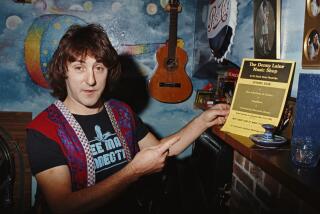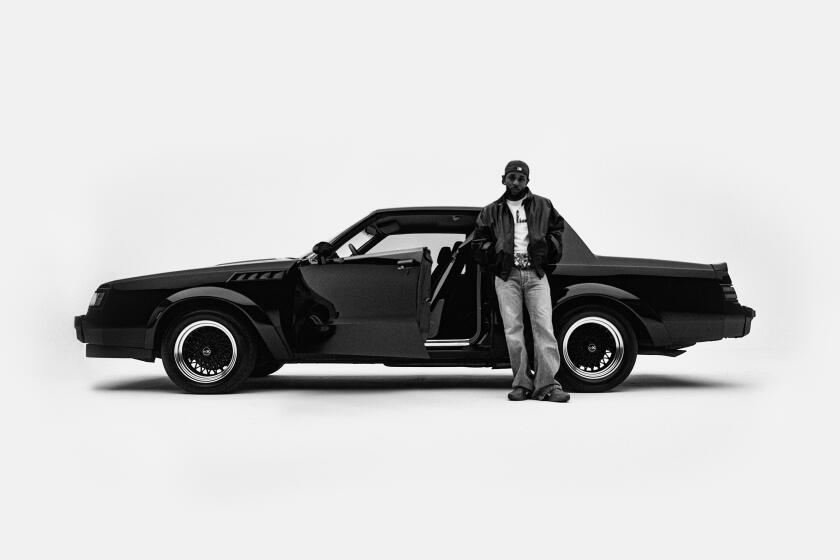FIGHTING BACK FROM REAL-LIFE BLUES
- Share via
Paul Butterfield played a central role in popularizing the blues with the ‘60s rock audience, but the Chicago-born harmonica player/vocalist never really learned what the blues is about until seven years ago.
“To make a long story short, my intestines burst,” Butterfield, 43, said by phone from a Bay Area hotel during a brief round of California club dates.
Butterfield (who appears Friday at Garfield’s in Huntington Beach and Sunday at the “Drums Across America” benefit at the Starlight Amphitheatre) was working on an album in Memphis when he was hit by an attack of diverticulitis that disrupted his career for almost four years.
“I ended up having four operations and you don’t realize what it takes out of you, energy-wise,” he said. “You think you can come right back, so I went back to work and herniated the scar tissue in my stomach. I had three hernias from playing harmonica, so it was a vicious circle.
“Sure, it occurred to me that I might not be able to play anymore, but I got that Irish ornery thing going and said, ‘I’m going to make it through this,’ and I did with a lot of help from God. I came through the wars there.”
Regaining his health wasn’t the only battle Butterfield had to fight to revive his career. Relations with his record company were so bad that he personally arranged the financing to record “The Legendary Paul Butterfield Rides Again,” his first album in five years. It took 18 months to sell the finished record to Amherst Records, the Buffalo-based label that will release the album next week.
Featuring Paul Shaffer from the “David Letterman Show” on keyboards, the album includes a Bob Dylan song written specifically for Butterfield. A version of Muddy Waters’ “Mannish Boy” is the only overt nod to his Chicago blues roots.
Butterfield grew up on the integrated South Side of Chicago and was one of the first young white musicians to venture into black blues clubs there. But blues wasn’t the only music that influenced his development in the late ‘50s and early ‘60s.
“I was exposed in person to Muddy Waters in his prime with Little Walter on harmonica and a little bell went off in my head,” Butterfield remembered.
“I’m not a musicologist--I’m a musician. I studied with the first flutist of the Chicago Symphony for seven years and that’s really where I got the tremolant (tremolo effect) on the harmonica. It’s also where I learned to play from my gut.”
The Butterfield Blues Band formed in 1963 with a black rhythm section drawn from Howlin’ Wolf’s band and guitarists Elvin Bishop and the late Michael Bloomfield.
The group’s first two Elektra albums were electrifying jolts of high-energy blues that paved the way for the British blues groups that inundated the rock world in the late ‘60s. When Bob Dylan outraged folk purists at the 1965 Newport Folk Festival by performing with an electric group, it was the Butterfield Band that backed him up.
Butterfield continued experimenting with different styles, working with a horn-laden big band until 1972. He then switched to an acoustic-electric lineup with his Better Days group and continued touring and recording through the ‘70s until the health problems curtailed his activity.
Butterfield moved here six months ago from New York to be closer to his two sons, and has been involved in various recording and demo projects. Happy with his new band--”They want to create rather than decimate,” he said with a chuckle--and his restored health, Butterfield is confident that contemporary audiences will readily welcome his new music.
“A lot of people relate me to the blues, but I don’t think it’s a hindrance at this point,” he said. “This really isn’t a blues album, but it has that blues inflection and still has my style to it.
“It’s like Ray Charles did country albums and it never changed his style. I just try to be the best Paul Butterfield I can be in my music.”
More to Read
The biggest entertainment stories
Get our big stories about Hollywood, film, television, music, arts, culture and more right in your inbox as soon as they publish.
You may occasionally receive promotional content from the Los Angeles Times.










